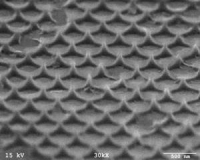By combining admicellar polymerization with an already-formed template, nanoscale polymer patterns can be produced. The pattern on the right represents the results when monodisperse spheres are formed as a monolayer on a flat surface, and the interstitial sites are where polymer forms. Surfactant is required to localize the monomer in the interstitial sites; otherwise polymer forms in solution and the result is an unordered system. We also have work being done in collaboration with the Center for Nanomaterial Science at Oak Ridge National Laboratories on this process.
Thin Films
A new, three-step process for the formation of ultrathin films has been developed by IASR. In the first step, aggregates of surfactant molecules are formed on the solid substrates by contacting the substrate with a surfactant solution. These surfactant aggregates can be formed on a great variety of surfaces in such a way as to result in bilayer coverage of the entire surface with surfactant.
In the second step of the process, a monomeric species is introduced. The surfactant layer acts as a two-dimensional solvent to concentrate the monomer at the interface. In the third step of the process, polymerization is initiated by chemical, thermal, or photochemical means. The bilayer serves to localize the polymerization reaction at the solution-solid interface. An optional fourth washing step can be added to produce a thin film with the polymer exposed as needed for some applications.
IASR researchers have successfully formed such films on high surface area TiO2, and AI2O3 powders, on single-crystal, molecularly smooth silica, mica and graphite, and on alumina-coated plastic chips. Measured films thicknesses have varied from 3 to 100 nm. Films have been formed from many monomers including tetrafluoroethylene, aniline, pyrrole, styrene, butadiene, isoprene, ethylene, propylene, and many others. Formation of a new type of polymer frequently can be achieved by adaptation of a system from the emulsion polymerization literature.Four U.S. patents have now been issued to IASR researchers on this process and on materials formed by this process.

Cotton is one of the most popular materials for clothing because fabrics made of cotton breathe and exhibit a nice feel. However, these fabrics also readily soak up water which can be uncomfortable and, in some situations, even dangerous. With many of the techniques used to make textiles water-repellant, desirable properties of cotton can be lost. Admicellar polymerization has been applied to make a water-repellent cotton fabric that retains its positive attributes. There is a link to a movie (caution-this file is 21 MB see below) that demonstrates how a coating of admicellar polymer dramatically alters the surface properties of the cotton, without signficantaly affecting the other desirable properties.
In polymer-matrix composites, the interface between the organic polymer and the inorganic filler determines many composite properties, in particular the the tensile or flexural strength. Admicellar polymerization has been shown to improve the interface for many polymer/filler combinations including synthetic rubber/silica; epoxy resin/glass and polyethylene/glass. Because of the versatility of the admicellar process, we expect this process to be completely general for all possible combinations of fillers and polymers; it is only necessary to find the right type of admicellar polymer for a particular polymer/filler pair.
Our laboratories have studied the adsorption of polymers on a variety of surfaces, and how that adsorption is modified by the addition of surfactant. We have found that the kinetics of adsorption are very different for the two systems; in the systems we have studied polymer tends to absorb faster than the surfactant, and over longer times surfactant will increase its surface concentration. This could be a displacement effect, or could be that surfactant is associating with polymer adsorbed at the surface (i.e. we have only measured relative changes). Ellipsometry, x-ray photoelectron spectroscopy, quartz crystal microbalance, contact angle measurements and chromotography are some of the methods that we have applied to these systems.
